Exhibitions
2016-3 MOMAT Collection
Date
-Location
Collection Gallery, from the fourth to second floors
The collection exhibition from November 22 , 2016 – February 12 , 2017

Welcome to the MOMAT Collection! Here are a few of the highlights of this installment of the exhibition.
Some of the Nihon-ga (Japanese-style paintings) are displayed for a limited period in order to help preserve the works. Of special note in this edition are several Important Cultural Properties, which are only shown publicly once a year. The exhibition is divided into two periods, the first running from Nov. 22 to Jan. 15, and the second from Jan. 17 to Feb. 12. During the former, viewers can enjoy Kaburaki Kiyokata’s Portrait of Sanyutei Encho in the Highlights section (Room 1, 4th floor), and during the latter, Yasuda Yukihiko’s Camp at Kisegawa (Room 10, 3rd floor).
This edition also includes several rooms devoted to individual artists. Room 3 (4th floor), for example, features the prominent Taisho Period painter Kishida Ryusei, and Room 4 focuses on the singular Nihon-ga painter Hada Teruo. Room 6 (3rd floor) showcases the war-record paintings of Nakamura Kenichi, and Room 7 is given over to Kawara On, an internationally renowned artist who died two years ago. Room 9 focuses on Alfred Stieglitz, one of the foremost American photographers.
Moreover, in conjunction with the Endless: The Paintings of Yamada Masaaki exhibition (held on the first floor), we present abstract paintings by some of Yamada’s contemporaries in Room 8 (3rd floor). And in conjunction with the Ei-Q 1935-1937: Seeking the “Real” in the Dark exhibition, held in Gallery 4 (2nd floor), we examine Japanese avant-garde painting of the 1930s in Room 5 (4th floor). Comparing these works with those on display in the special exhibitions promises an even more enjoyable viewing experience.
Take your time and savor the many and varied pleasures of this edition of the MOMAT Collection.
◆Works in the exhibition are subject to change.
The first: November 22 , 2016 – January 15, 2017
The second: January 17, 2017 – February 12 , 2017
Important Cultural Properties on display
The National Museum of Modern Art, Tokyo Collection (main building) contains 14 items that have been designated by the Japanese government as Important Cultural Properties. These include nine Nihon-ga (Japanese-style) paintings, four oil paintings, and one sculpture. (One of the Nihon-ga paintings and one of the oil paintings are on long-term loan to the museum.)
The following Important Cultural Properties are shown in this period:
■Yorozu Tetsugoro, Nude Beauty, 1912
■Nakamura Tsune, Portrait of Vasilii Yaroshenko , 1920
■Kaburaki Kiyokata, Portrait of San’yutei Encho , 1930 (Exhibit Date: November 22 , 2016 – January 15, 2017)
■Yasuda Yukihiko, Camp at Kisegawa, 1940/41(Exhibit Date: January 17, 2017 – February 12 , 2017)
◆Please visit the Important Cultural Property section Masterpieces for more information about the pieces.
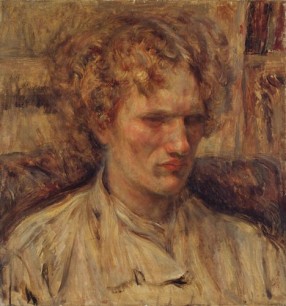
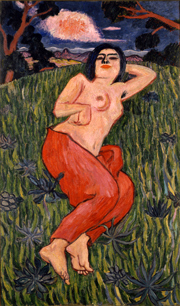
List of Works
MOMAT Collection November 22, 2016 – February 12, 2017
*Please note that the exhibits and the exhibition schedule are subject to change without previous notice. For up-to-date information, please kindly check our website.
*F: November 22, 2016 – January 15, 2017
*S: January 17, 2017 – February 12, 2017
| 展示室 (Shown on/at;Room No.) | 重文 (Important Cultural Property) | 音声ガイド (Audio Guide) | 期間 | 作家名 | 作品名 | 制作年 date | 技法 | 収蔵経緯、寄贈、寄託 | Name of the Artist | Title | Material (technique, support) |
|---|---|---|---|---|---|---|---|---|---|---|---|
| 1室 | 結城素明 | 囀(さえずり) | 1911 | 紙本彩色 | 購入 | YUKI, Somei | Bird Twittering | color on paper | |||
| 1室 | F | 吉川霊華 | 藐姑射之処子 (はこやのしょし) | 1918 | 紙本彩色 | 購入 | KIKKAWA, Reika | Virgin at Mt. Hakoya | color on paper | ||
| 1室 | 平福百穂 | 丹鶴青瀾 | 1926 | 絹本彩色 | 三笠宮崇仁親王殿下寄贈 | HIRAFUKU, Hyakusui | Crane and Blue Waves | color on silk | |||
| 1室 | S | 吉川霊華 | 離騒(りそう) | 1926 | 紙本墨画淡彩 | 購入 | KIKKAWA, Reika | On Encountering Sorrow from The Poem by Qu Yuan | sumi and color on paper | ||
| 1室 | ◎ | 48 | F | 鏑木清方 | 三遊亭円朝像 | 1930 | 絹本彩色 | 購入 | KABURAKI, Kiyokata | Portrait of San’yutei Encho | color on silk |
| 1室 | 12 | 荻原守衛 | 女 | 1910 | ブロンズ | 文部省管理換 | OGIWARA, Morie | Woman | bronze | ||
| 1室 | 21 | 村山槐多 | バラと少女 | 1917 | 油彩・キャンバス | 山本孝氏寄贈 | MURAYAMA, Kaita | Roses and a Girl | oil on canvas | ||
| 1室 | 27 | 関根正二 | 三星(さんせい) | 1919 | 油彩・キャンバス | 購入 | SEKINE, Shoji | Three Stars | oil on canvas | ||
| 1室 | ◎ | 29 | 中村彝 | エロシェンコ氏の像 | 1920 | 油彩・キャンバス | 大里一太郎氏寄贈 | NAKAMURA, Tsune | Portrait of Vasilii Yaroshenko | oil on canvas | |
| 1室 | 51 | 安井曽太郎 | 奥入瀬の溪流 | 1933 | 油彩・キャンバス | 文化庁管理換 | YASUI, Sotaro | Oirase Stream | oil on canvas | ||
| 1室 | 42 | 野田英夫 | 帰路 | 1935 | 油彩・キャンバス | 購入 | NODA, Hideo | Way Home | oil on canvas | ||
| 1室 | 62 | 靉光 | 眼のある風景 | 1938 | 油彩・キャンバス | 購入 | AI-MITSU | Landscape with an Eye | oil on canvas | ||
| 1室 | 松本竣介 | 黒い花 | 1940 | 油彩・板 | 購入 | MATSUMOTO, Shunsuke | Black Flowers | oil on board | |||
| 1室 | 59 | 梅原龍三郎 | 北京秋天 | 1942 | 油彩、岩絵具・紙 | 川口松太郎氏寄贈 | UMEHARA, Ryuzaburo | Autumn in Beijing | oil and Japanese pigment on paper | ||
| 1室 | ポール・セザンヌ | 大きな花束 | c.1892-95 | 油彩・キャンバス | 購入 | Paul Cézanne | Grand Bouquet of Flowers | oil on canvas | |||
| 1室 | 3 | アンリ・ルソー | 第22回アンデパンダン展に参加するよう芸術家達を導く自由の女神 | 1905-06 | 油彩・キャンバス | 購入 | Henri Rousseau | Liberty Inviting Artists to Take Part in the 22nd Exhibition of the Société des Artistes Indépendants | oil on canvas | ||
| 1室 | ジョルジュ・ブラック | 女のトルソ | 1910-11 | 油彩・キャンバス | 購入 | Georges Braque | Female Torso | oil on canvas | |||
| 2室 | 8 | 竹内栖鳳 | 飼われたる猿と兎 | 1908 | 絹本彩色 | 文部省管理換 | TAKEUCHI, Seiho | Monkeys and Rabbits | color on silk | ||
| 2室 | F | 横山大観 | 暮色 | 1922 | 絹本彩色 | 文化庁管理換 | YOKOYAMA, Taikan | Evening Twilight | color on silk | ||
| 2室 | F | 入江波光 | 蒼林図 | 1923 | 絹本彩色 | 文化庁管理換 | IRIE, Hako | Green Grove | color on silk | ||
| 2室 | 33 | S | 速水御舟 | 門(名主の家) | 1924 | 紙本彩色 | 文化庁管理換 | HAYAMI, Gyoshu | Gate (Residence of the Village Head) | color on paper | |
| 2室 | 35 | S | 村上華岳 | 松山雲煙 | 1925 | 絹本彩色 | 購入 | MURAKAMI, Kagaku | Pine-covered Mountains in the Mist | color on silk | |
| 2室 | 熊谷守一 | 半裸婦 | 1904 | 油彩・板 | 川上淳氏寄贈 | KUMAGAI, Morikazu | Half Naked | oil on board | |||
| 2室 | 和田英作 | おうな | 1908 | 油彩・キャンバス | 文部省管理換 | WADA, Eisaku | Old Woman | oil on canvas | |||
| 2室 | 小杉放菴(未醒) | 水郷 | 1911 | 油彩・キャンバス | 文部省管理換 | KOSUGI, Hoan (Misei) | Waterside Village | oil on canvas | |||
| 2室 | 南薫造 | 六月の日 | 1912 | 油彩・キャンバス | 文部省管理換 | MINAMI, Kunzo | One Day in June | oil on canvas | |||
| 2室 | ◎ | 17 | 萬鉄五郎 | 裸体美人 | 1912 | 油彩・キャンバス | 八木正治氏寄贈 | YOROZU, Tetsugoro | Nude Beauty | oil on canvas | |
| 2室 | 萬鉄五郎 | 太陽の麦畑 | c.1913 | 油彩・板 | 購入 | YOROZU, Tetsugoro | A Cornfield in the Sun | oil on board | |||
| 3室 | 岸田劉生 | 自画像 | 1913 | 油彩・キャンバス | 杉本健吉氏寄贈 | KISHIDA, Ryusei | Self-Portrait | oil on canvas | |||
| 3室 | 岸田劉生 | 自画像 | 1914 | 油彩・キャンバス | 杉本健吉氏寄贈 | KISHIDA, Ryusei | Self-Portrait | oil on canvas | |||
| 3室 | 岸田劉生 | 壺の上に林檎が載って在る | 1916 | 油彩・板 | 文化庁管理換 | KISHIDA, Ryusei | An Apple Exists on Top of a Pot | oil on board | |||
| 3室 | 岸田劉生 | 古屋君の肖像 (草持てる男の肖像) | 1916 | 油彩・キャンバス | 購入 | KISHIDA, Ryusei | Portrait of Koya Yoshio(Portrait of a Man Holding a Plant) | oil on canvas | |||
| 3室 | 23 | 岸田劉生 | 麗子肖像(麗子五歳之像) | 1918 | 油彩・キャンバス | 購入 | KISHIDA, Ryusei | Reiko, Five Years Old | oil on canvas | ||
| 3室 | 岸田劉生 | 蕪図 | 1925 | 油彩・キャンバス | 寄託 | KISHIDA, Ryusei | Turnip | oil on canvas | |||
| 3室 | 岸田劉生 | 自画像 | 1908 | 鉛筆・紙 | 大畑照子氏遺贈 | KISHIDA, Ryusei | Self-Portrait | pencil on paper | |||
| 3室 | 岸田劉生 | ほろよい | c.1910 | 鉛筆、水彩・紙 | 大畑照子氏遺贈 | KISHIDA, Ryusei | Tipsiness | pencil and watercolor on paper | |||
| 3室 | 岸田劉生 | 古屋芳雄像 | 1916 | 水彩・紙 | 古屋康子氏遺贈 | KISHIDA, Ryusei | Portrait of Koya Yoshio | watercolor on paper | |||
| 3室 | 岸田劉生 | 麗子六歳之像 | 1919 | 水彩・紙 | 岩波茂雄氏旧蔵、岩波雄二郎氏遺贈 | KISHIDA, Ryusei | Reiko, Six Years Old | watercolor on paper | |||
| 3室 | 岸田劉生 | 村嬢於松之坐像 | 1920 | 水彩、鉛筆・紙 | 森美子氏・奈良道氏・松尾香代子氏寄贈 | KISHIDA, Ryusei | Portrait of Sitting Omatsu, a Village Girl | watercolor and pencil on paper | |||
| 3室 | 岸田劉生 | 童児肖像 | 1921 | 水彩・紙 | 寄託 | KISHIDA, Ryusei | Portrait of a Little Boy | watercolor on paper | |||
| 3室 | 岸田劉生 | 村嬢於松立像 | 1921 | 水彩、鉛筆・紙 | 尾崎佐喜子氏寄贈 | KISHIDA, Ryusei | Portrait of Standing Omatsu, a Village Girl | watercolor and pencil on paper | |||
| 3室 | 岸田劉生 | 岸田劉生作品個人展覧会ポスター (東京展) | 1919 | 木版(多色) | 岸田鶴之助氏遺贈 | KISHIDA, Ryusei | Poster for the Solo-exhibition of Ryusei Kishida (Exhibition in Tokyo) | color woodcut | |||
| 3室 | 岸田劉生 | 岸田劉生作品個人展覧会ポスター (京都展) | 1919 | 木版(多色) | 岸田鶴之助氏遺贈 | KISHIDA, Ryusei | Poster for the Solo-exhibition of Ryusei Kishida (Exhibition in Kyoto) | color woodcut | |||
| 4室 | 秦テルヲ | 自画像 | 1916 | 紙本墨画 | 有限会社えびな書店寄贈 | HADA, Teruo | Self Portrait | sumi on paper | |||
| 4室 | 秦テルヲ | 黒烟 | c.1916 | インク・紙 | 購入 | HADA, Teruo | Black Smoke | ink on paper | |||
| 4室 | 秦テルヲ | 開かぬ扉 | c.1916 | インク・紙 | 購入 | HADA, Teruo | Locked Door | ink on paper | |||
| 4室 | 秦テルヲ | 死んで逝く | c.1916 | インク・紙 | 購入 | HADA, Teruo | Dying a Death | ink on paper | |||
| 4室 | 秦テルヲ | 月光 | c.1916 | インク、色鉛筆・紙 | 購入 | HADA, Teruo | Moonlight | ink and color pencil on paper | |||
| 4室 | 秦テルヲ | 惨しき日 | c.1916 | インク、色鉛筆・紙 | 購入 | HADA, Teruo | A Miserable Day | ink and color pencil on paper | |||
| 4室 | 秦テルヲ | 燈火 | c.1916 | インク、色鉛筆・紙 | 購入 | HADA, Teruo | Lamplight | ink and color pencil on paper | |||
| 4室 | 秦テルヲ | 無題 | c.1916 | インク・紙 | 購入 | HADA, Teruo | Untitled | ink on paper | |||
| 4室 | 秦テルヲ | 無題 | c.1916 | インク・紙 | 購入 | HADA, Teruo | Untitled | ink on paper | |||
| 4室 | 秦テルヲ | 落日 | c.1916 | インク、色鉛筆・紙 | 購入 | HADA, Teruo | Sunset | ink and color pencil on paper | |||
| 4室 | 秦テルヲ | 活動の女給 | c.1916 | インク、色鉛筆・紙 | 購入 | HADA, Teruo | Waitress at the Cinema | ink and color pencil on paper | |||
| 4室 | 秦テルヲ | 煙 | c.1916 | インク、色鉛筆・紙 | 購入 | HADA, Teruo | Smoke | ink and color pencil on paper | |||
| 5室 | 41 | 福沢一郎 | Poisson d’Avril(四月馬鹿) | 1930 | 油彩・キャンバス | 作者寄贈 | FUKUZAWA, Ichiro | April Fool | oil on canvas | ||
| 5室 | 福沢一郎 | 牛 | 1936 | 油彩・キャンバス | 作者寄贈 | FUKUZAWA, Ichiro | Oxen | oil on canvas | |||
| 5室 | 吉原治良 | 朝顔と土蔵 | c.1931-34 | 油彩・キャンバス | 清水夏生氏寄贈 | YOSHIHARA, Jiro | Morning Glories and Storehouse | oil on canvas | |||
| 5室 | 吉原治良 | 作品2 | c.1934 | 油彩・キャンバス | 購入 | YOSHIHARA, Jiro | Work 2 | oil on canvas | |||
| 5室 | 三岸好太郎 | 雲の上を飛ぶ蝶 | 1934 | 油彩・キャンバス | 購入 | MIGISHI, Kotaro | Butterflies Flying above Clouds | oil on canvas | |||
| 5室 | 岡本太郎 | コントルポアン | 1935/54 | 油彩・キャンバス | 購入 | OKAMOTO, Taro | Counterpoint | oil on canvas | |||
| 5室 | 長谷川三郎 | アブストラクション | 1936 | 油彩・キャンバス | 購入 | HASEGAWA, Saburo | Abstraction | oil on canvas | |||
| 5室 | 北脇昇 | 最も静かなる時 | 1937 | 油彩・キャンバス | 北脇かね氏寄贈 | KITAWAKI, Noboru | The Quietest Time | oil on canvas | |||
| 5室 | 村井正誠 | URBAIN | 1937 | 油彩・キャンバス | 購入 | MURAI, Masanari | Urban | oil on canvas | |||
| 5室 | 浅原清隆 | 郷愁 | 1938 | 油彩・キャンバス | 渡辺美枝子氏寄贈 | ASAHARA, Kiyotaka | Nostalgia | oil on canvas | |||
| 5室 | 浜田浜雄 | ユパス | 1939 | 油彩・キャンバス | 購入 | HAMADA, Hamao | Upas | oil on canvas | |||
| 5室 | オノサト・トシノブ(小野里利信) | 黒白の丸 | 1940 | 油彩・キャンバス | 購入 | ONOSATO, Toshinobu | Circles in Black and White | oil on canvas | |||
| 5室 | 古賀春江 | そこに在る | 1933 | 水彩、鉛筆・紙 | 高松太郎氏寄贈 | KOGA, Harue | Being | watercolor and pencil on paper | |||
| 5室 | 古賀春江 | 楽しき饗宴 | 1933 | 水彩、鉛筆・紙 | 高松太郎氏寄贈 | KOGA, Harue | Pleasant Feast | watercolor and pencil on paper | |||
| 6室 | 中村研一 | マレー沖海戦 | 1942 | 油彩・キャンバス | 無期限貸与 | NAKAMURA, Ken’ichi | Naval Battle off Malaya | oil on canvas | |||
| 6室 | 中村研一 | コタ・バル | 1942 | 油彩・キャンバス | 無期限貸与 | NAKAMURA, Ken’ichi | Kota Baru | oil on canvas | |||
| 6室 | 中村研一 | 珊瑚海海戦 | 1943 | 油彩・キャンバス | 無期限貸与 | NAKAMURA, Ken’ichi | Battle of the Coral Sea | oil on canvas | |||
| 6室 | 中村研一 | タサファロング(ガダルカナルに於ける陸海共同作戦図) | 1944 | 油彩・キャンバス | 無期限貸与 | NAKAMURA, Ken’ichi | Army-Navy Joint Operations on Tasivarongo Point, Guadalcanal | oil on canvas | |||
| 6室 | 中村研一 | コタ・バル B | 1944 | 油彩・キャンバス | 無期限貸与 | NAKAMURA, Ken’ichi | Kota Baru B | oil on canvas | |||
| 6室 | 中村研一 | 北九州上空野辺軍曹機の体当りB29二機を撃墜す | 1945 | 油彩・キャンバス | 無期限貸与 | NAKAMURA, Ken’ichi | Sergeant Nobe’s Suicide Attack on Two B-29’s Over Kitakyushu | oil on canvas | |||
| 7室 | 河原温 | 浴室1 | 1953 | 鉛筆・紙 | 作者寄贈 | KAWARA, On | Bathroom 1 | pencil on paper | |||
| 7室 | 河原温 | 浴室2 | 1953 | 鉛筆・紙 | 作者寄贈 | KAWARA, On | Bathroom 2 | pencil on paper | |||
| 7室 | 河原温 | 浴室3 | 1953 | 鉛筆・紙 | 作者寄贈 | KAWARA, On | Bathroom 3 | pencil on paper | |||
| 7室 | 河原温 | 浴室4 | 1953 | 鉛筆・紙 | 作者寄贈 | KAWARA, On | Bathroom 4 | pencil on paper | |||
| 7室 | 河原温 | 浴室5 | 1953 | 鉛筆、色鉛筆・紙 | 作者寄贈 | KAWARA, On | Bathroom 5 | pencil and color pencil on paper | |||
| 7室 | 河原温 | 浴室6 | 1953-54 | 鉛筆、色鉛筆・紙 | 作者寄贈 | KAWARA, On | Bathroom 6 | pencil and color pencil on paper | |||
| 7室 | 河原温 | 浴室7 | 1953 | 鉛筆、色鉛筆・紙 | 作者寄贈 | KAWARA, On | Bathroom 7 | pencil and color pencil on paper | |||
| 7室 | 河原温 | 浴室8 | 1953 | 鉛筆・紙 | 作者寄贈 | KAWARA, On | Bathroom 8 | pencil on paper | |||
| 7室 | 河原温 | 浴室9 | 1953 | 鉛筆、色鉛筆・紙 | 作者寄贈 | KAWARA, On | Bathroom 9 | pencil and color pencil on paper | |||
| 7室 | 河原温 | 浴室10 | 1953 | 鉛筆・紙 | 作者寄贈 | KAWARA, On | Bathroom 10 | pencil on paper | |||
| 7室 | 河原温 | 浴室11 | 1953 | 鉛筆、色鉛筆・紙 | 作者寄贈 | KAWARA, On | Bathroom 11 | pencil and color pencil on paper | |||
| 7室 | 河原温 | 浴室12 | 1953 | 鉛筆・紙 | 作者寄贈 | KAWARA, On | Bathroom 12 | pencil on paper | |||
| 7室 | 河原温 | 浴室13 | 1953 | 鉛筆・紙 | 作者寄贈 | KAWARA, On | Bathroom 13 | pencil on paper | |||
| 7室 | 河原温 | 浴室14 | 1953 | 鉛筆・紙 | 作者寄贈 | KAWARA, On | Bathroom 14 | pencil on paper | |||
| 7室 | 河原温 | 浴室15 | 1953 | 鉛筆・紙 | 作者寄贈 | KAWARA, On | Bathroom 15 | pencil on paper | |||
| 7室 | 河原温 | 浴室16 | 1953 | 鉛筆・紙 | 作者寄贈 | KAWARA, On | Bathroom 16 | pencil on paper | |||
| 7室 | 河原温 | 浴室17 | 1953-54 | 鉛筆・紙 | 作者寄贈 | KAWARA, On | Bathroom 17 | pencil on paper | |||
| 7室 | 河原温 | 浴室18 | 1953 | 鉛筆、色鉛筆・紙 | 作者寄贈 | KAWARA, On | Bathroom 18 | pencil and color pencil on paper | |||
| 7室 | 河原温 | 浴室19 | 1953 | 鉛筆・紙 | 作者寄贈 | KAWARA, On | Bathroom 19 | pencil on paper | |||
| 7室 | 河原温 | 浴室20 | 1953 | 鉛筆、色鉛筆・紙 | 作者寄贈 | KAWARA, On | Bathroom 20 | pencil and color pencil on paper | |||
| 7室 | 河原温 | 浴室21 | 1953 | 鉛筆、色鉛筆・紙 | 作者寄贈 | KAWARA, On | Bathroom 21 | pencil and color pencil on paper | |||
| 7室 | 河原温 | 浴室22 | 1953 | 鉛筆、色鉛筆・紙 | 作者寄贈 | KAWARA, On | Bathroom 22 | pencil and color pencil on paper | |||
| 7室 | 河原温 | 浴室23 | 1953 | 鉛筆、色鉛筆・紙 | 作者寄贈 | KAWARA, On | Bathroom 23 | pencil and color pencil on paper | |||
| 7室 | 河原温 | 浴室24 | 1954 | 鉛筆・紙 | 作者寄贈 | KAWARA, On | Bathroom 24 | pencil on paper | |||
| 7室 | 河原温 | 浴室25 | 1953 | 鉛筆・紙 | 作者寄贈 | KAWARA, On | Bathroom 25 | pencil on paper | |||
| 7室 | 河原温 | 浴室26 | 1954 | 鉛筆・紙 | 作者寄贈 | KAWARA, On | Bathroom 26 | pencil on paper | |||
| 7室 | 河原温 | 浴室27 | 1953-54 | 鉛筆・紙 | 作者寄贈 | KAWARA, On | Bathroom 27 | pencil on paper | |||
| 7室 | 河原温 | 浴室28 | 1954 | 鉛筆・紙 | 作者寄贈 | KAWARA, On | Bathroom 28 | pencil on paper | |||
| 7室 | 79 | 河原温 | 孕んだ女 | 1954 | 油彩・キャンバス | 作者寄贈 | KAWARA, On | Pregnant Woman | oil on canvas | ||
| 7室 | 河原温 | DEC. 14, 1966 | 1966 | アクリリック・キャンバス | 寄託 | KAWARA, On | DEC. 14, 1966 | acrylic on canvas | |||
| 7室 | 河原温 | Date Painting | 1994 | アクリリック・キャンバス | 寄託 | KAWARA, On | Date Painting | acrylic on canvas | |||
| 7室 | 河原温 | Date Painting | 1994 | アクリリック・キャンバス | 寄託 | KAWARA, On | Date Painting | acrylic on canvas | |||
| 7室 | 河原温 | Date Painting | 1994 | アクリリック・キャンバス | 寄託 | KAWARA, On | Date Painting | acrylic on canvas | |||
| 8室 | 桑山忠明 | 無題(赤) | 1961 | 岩絵具、銀箔・和紙(麻布裏打ち) | 購入 | KUWAYAMA, Tadaaki | Untitled (Red) | Japanese pigment and silver leaf on Japanese paper, mounted on canvas | |||
| 8室 | オノサト・トシノブ(小野里利信) | 作品100-B | 1963 | 油彩・キャンバス | 藤岡時彦氏寄贈―妻英子を偲んで | ONOSATO, Toshinobu | Work 100-B | oil on canvas | |||
| 8室 | 堂本尚郎 | 連続の溶解 64-10 | 1964 | 油彩・キャンバス | 購入 | DOMOTO, Hisao | Solutions of Continuities 64-10 | oil on canvas | |||
| 8室 | 岩本拓郎 | SQUARE-92-5<海=黄色いヴェール> | 1992 | アクリルウレタン塗料・和紙(板に貼付) | 購入 | IWAMOTO, Takuro | SQUARE-92-5 <Sea=Yellow Veil> | acrylic polyurethan on paper, mounted on board | |||
| 8室 | 沢居曜子 | Carbon Work Ⅱ- 5 | 1977 | カーボン・和紙 | 山口孝氏寄贈 | SAWAI, Yoko | Carbon Work Ⅱ- 5 | carbon on paper | |||
| 8室 | 沢居曜子 | Line Work Ⅱ – 77 – 3 | 1977 | コンテ・ケント紙 | 山口孝氏寄贈 | SAWAI, Yoko | Line Work Ⅱ – 77 – 3 | conté on paper | |||
| 8室 | 辰野登恵子 | UNTITLED-29 | 1974 | 孔版 | 購入 | TATSUNO, Toeko | UNTITLED-29 | silkscreen | |||
| 8室 | 辰野登恵子 | UNTITLED-30 | 1974 | 孔版 | 購入 | TATSUNO, Toeko | UNTITLED-30 | silkscreen | |||
| 8室 | 田中信太郎 | 無域 | 1999 | 真鍮 | 購入 | TANAKA, Shintaro | Without Bounds | brass | |||
| 8室 | アド・ラインハート | 抽象絵画 | 1958 | 油彩・キャンバス | 購入 | Ad Reinhardt | Abstract Painting | oil on canvas | |||
| 8室 | ジョセフ・アルバース | 正方形讃歌 | 1959 | 油彩・キャンバス | 購入 | Josef Albers | Homage to the Square | oil on canvas | |||
| 8室 | ブリンキー・パレルモ | 四つの原型 | 1970 | 孔版 | 購入 | Blinky Palermo | Four Prototypes | silkscreen, 4 pieces | |||
| 9室 | アルフレッド・スティーグリッツ | 冬、五番街 | 1893 (1905 print) | フォトグラヴュア | 購入 | Alfred Stieglitz | Winter-5th Avenue | photogravure | |||
| 9室 | アルフレッド・スティーグリッツ | 終着駅、ニューヨーク | 1893 | フォトグラヴュア | ジョージア・オキーフ氏寄贈 | Alfred Stieglitz | The Terminal (New York) | photogravure | |||
| 9室 | アルフレッド・スティーグリッツ | 五番街・街頭風景 | 1896 | フォトグラヴュア | ジョージア・オキーフ氏寄贈 | Alfred Stieglitz | The Street, Fifth Avenue | photogravure | |||
| 9室 | アルフレッド・スティーグリッツ | ザ・ハンド・オブ・マン | 1902 (1911 print) | フォトグラヴュア | 購入 | Alfred Stieglitz | The Hand of Man | photogravure | |||
| 9室 | アルフレッド・スティーグリッツ | 三等船室 | 1907 (1911 print) | フォトグラヴュール | ジョージア・オキーフ氏寄贈 | Alfred Stieglitz | The Steerage | photogravure | |||
| 9室 | アルフレッド・スティーグリッツ | マンハッタン南部 | 1910 (1911 print) | フォトグラヴュア | 購入 | Alfred Stieglitz | Lower Manhattan | photogravure | |||
| 9室 | アルフレッド・スティーグリッツ | 新旧のニューヨーク | 1910 (1911 print) | フォトグラヴュア | 購入 | Alfred Stieglitz | Old and New New York | photogravure | |||
| 9室 | アルフレッド・スティーグリッツ | 飛行船 | 1910 | ゼラチン・シルバー・プリント | ジョージア・オキーフ氏寄贈 | Alfred Stieglitz | A Dirigible | gelatin silver print | |||
| 9室 | アルフレッド・スティーグリッツ | ジョージア・オキーフ: ある肖像 | 1918 | パラディウム・プリント | ジョージア・オキーフ氏寄贈 | Alfred Stieglitz | Georgia O’Keeffe: A Portrait | palladium print | |||
| 9室 | アルフレッド・スティーグリッツ | ジョージア・オキーフ: ある肖像―手と指貫 | 1919 | パラディウム・プリント | ジョージア・オキーフ氏寄贈 | Alfred Stieglitz | Georgia O’Keeffe: A Portrait- Hands and Thimble | palladium print | |||
| 9室 | アルフレッド・スティーグリッツ | ジョージア・オキーフ: ある肖像―横顔 | 1920 | パラディウム・プリント | ジョージア・オキーフ氏寄贈 | Alfred Stieglitz | Georgia O’Keeffe: A portrait- Profile | palladium print | |||
| 9室 | アルフレッド・スティーグリッツ | 虹、ジョージ湖 | c.1920 | ゼラチン・シルバー・プリント | ジョージア・オキーフ氏寄贈 | Alfred Stieglitz | Rainbow, Lake George | gelatin silver print | |||
| 9室 | アルフレッド・スティーグリッツ | ジョージ湖 | 1922 | ゼラチン・シルバー・プリント | ジョージア・オキーフ氏寄贈 | Alfred Stieglitz | Lake George | gelatin silver print | |||
| 9室 | アルフレッド・スティーグリッツ | ジョージア・オキーフ: ある肖像 | 1923 | ゼラチン・シルバー・プリント | ジョージア・オキーフ氏寄贈 | Alfred Stieglitz | Georgia O’Keeffe: A Portrait | gelatin silver print | |||
| 9室 | アルフレッド・スティーグリッツ | イクィヴァレント | 1925 | ゼラチン・シルバー・プリント | ジョージア・オキーフ氏寄贈 | Alfred Stieglitz | Equivalent | gelatin silver print | |||
| 9室 | アルフレッド・スティーグリッツ | イクィヴァレント | 1926 | ゼラチン・シルバー・プリント | ジョージア・オキーフ氏寄贈 | Alfred Stieglitz | Equivalent | gelatin silver print | |||
| 9室 | アルフレッド・スティーグリッツ | 枯れかけた栗の木、ジョージ湖 | c.1927 | ゼラチン・シルバー・プリント | ジョージア・オキーフ氏寄贈 | Alfred Stieglitz | Dying Chestnut Trees, Lake George | gelatin silver print | |||
| 9室 | アルフレッド・スティーグリッツ | 夜―ニューヨーク | 1931-32 | ゼラチン・シルバー・プリント | ジョージア・オキーフ氏寄贈 | Alfred Stieglitz | Night- New York | gelatin silver print | |||
| 9室 | アルフレッド・スティーグリッツ | ニューヨーク (シェルトン・ホテル西側より) | 1931-32 | ゼラチン・シルバー・プリント | ジョージア・オキーフ氏寄贈 | Alfred Stieglitz | New York (from the Shelton Westward) | gelatin silver print | |||
| 10室 | F | 川合玉堂 | 小松内府図 | 1899 | 絹本彩色 | 購入 | KAWAI, Gyokudo | Taira Shigemori, Komatsu-no-naifu | color on silk | ||
| 10室 | F | 野田九浦 | 辻説法 | 1907 | 絹本彩色 | 文部省管理換 | NODA, Kyuho | Street Preaching | color on silk | ||
| 10室 | F | 今村紫紅 | 時宗 | 1908 | 絹本彩色 | 購入 | IMAMURA, Shiko | Hojo Tokimune Consulting Mugaku Sogen about the Mongol Invasion | color on silk | ||
| 10室 | 尾竹国観 | 油断 | 1909 | 絹本彩色 | 文部省管理換 | OTAKE, Kokkan | Alarmed | color on silk | |||
| 10室 | 菊池契月 | 供燈 (くとう) | 1910 | 絹本彩色 | 文部省管理換 | KIKUCHI, Keigetsu | Dedicating Lanterns | color on silk | |||
| 10室 | 下村観山 | 大原御幸 (おおはらごこう) | 1908 | 絹本彩色 | 購入 | SHIMOMURA, Kanzan | Ohara-Goko, from the Tale of Heike | color on silk | |||
| 10室 | F | 下村観山 | 清涼殿 | 1924 | 絹本彩色 | 寄贈 | SHIMOMURA, Kanzan | Seiryoden [royal hall] | color on silk | ||
| 10室 | S | 小山栄達 | 謙信公 | 1930 | 絹本墨画 | 東京国立博物館管理換 | KOYAMA, Eitatsu | Uesugi Kenshin | sumi on silk | ||
| 10室 | 小山栄達 | 木村長門出陣 | 1942 | 絹本彩色 | 東京国立博物館管理換 | KOYAMA, Eitatsu | Kimura Shigenari Departing for the Front | color on silk | |||
| 10室 | 吉村忠夫 | 燈籠大臣 | 1936 | 絹本彩色 | 文部省管理換 | YOSHIMURA, Tadao | Taira Shigemori, minister of lantern | color on silk | |||
| 10室 | ◎ | 61 | S | 安田靫彦 | 黄瀬川陣 | 1940/41 | 紙本彩色 | 文化庁管理換 | YASUDA, Yukihiko | Camp at Kisegawa | color on paper |
| 10室 | 植中直斎 | 重成夫人 | 1942 | 絹本彩色 | 東京国立博物館管理換 | UENAKA, Chokusai | Lady Kimura Shigenari | color on silk | |||
| 10室 | F | 前田青邨 | 清正 | 1942 | 紙本彩色 | 東京国立博物館管理換 | MAEDA, Seison | Kato Kiyomasa | color on paper | ||
| 10室 | 前田青邨 | かちかち山 | 1947 | 紙本墨画 | 作者寄贈 | MAEDA, Seison | Kachi-kachi-yama, the story of a rabbit and a racoon dog | sumi on paper | |||
| 10室 | 前田青邨 | 御嶽神社赤威冑 | 1927 | 墨、彩色・紙 | 作者寄贈 | MAEDA, Seison | Red-Braided Helmet of the Mitake Shrine | sumi and color on paper | |||
| 10室 | 稗田一穂 | 奇異鳥 | 1952 | 紙本彩色 | 購入 | HIEDA, Kazuho | Kiwi | color on paper | |||
| 10室 | 上村松篁 | 星五位 (ほしごい) | 1958 | 紙本彩色 | 購入 | UEMURA, Shoko | Night Herons | color on paper | |||
| 10室 | 岩橋英遠 | 鴇 | 1960 | 紙本彩色 | 五藤きみえ氏寄贈 | IWAHASHI, Eien | Japanese Crested Ibises | color on paper | |||
| 10室 | 堀文子 | 霧の野 | 1960 | 紙本彩色 | 文部省管理換 | HORI, Fumiko | Field Veiled in a Mist | color on paper | |||
| 10室 | 山口蓬春 | 秋 | 1961 | 紙本彩色 | 作者寄贈 | YAMAGUCHI, Hoshun | Autumn | color on paper | |||
| 10室 | 麻田辨自 | 鴛 | 1962 | 紙本彩色 | 文化庁管理換 | ASADA, Benji | Mandarin Ducks | color on paper | |||
| 10室 | 山本丘人 | 狭霧野 | 1970 | 紙本彩色 | 作者寄贈 | YAMAMOTO, Kyujin | Misty Field | color on paper | |||
| 3F、EVホール | 柳原義達 | 犬の唄 | 1961 | ブロンズ | 作者寄贈 | YANAGIHARA, Yoshitatsu | Song of the Dog | bronze | |||
| 3F、EVホール | 舟越保武 | 原の城 | 1971 | ブロンズ | 購入 | FUNAKOSHI, Yasutake | Haranojo Castle | bronze | |||
| 11室 | 向井良吉 | 蟻の城 | 1960 | アルミニウム | 購入 | MUKAI, Ryokichi | Castle of Ants | aluminum | |||
| 11室 | 82 | 三木富雄 | EAR | 1965 | アルミニウム | 購入 | MIKI, Tomio | EAR | aluminum | ||
| 11室 | 菅木志雄 | 止空散様 | 2004 | アルミニウム、石 | 作者寄贈 | SUGA, Kishio | To-ku-san-yo | aluminum and stone | |||
| 12室 | 宮脇愛子 | スクロール・ペインティング 白 | 1975 | アクリリック・キャンバス | 作者寄贈 | MIYAWAKI, Aiko | Scroll Painting, White | acrylic on canvas | |||
| 12室 | 宮脇愛子 | スクロール・ペインティング 黒 | 1976 | アクリリック・キャンバス | 作者寄贈 | MIYAWAKI, Aiko | Scroll Painting, Black | acrylic on canvas | |||
| 12室 | 斎藤義重 | “反対称”正方形 No.1, No.2 | 1976 | 木 | 購入 | SAITO, Yoshishige | “Dissymmetry” Square No.1, No.2 | wood, 2 pieces | |||
| 12室 | 李禹煥 | 線より | 1977 | 岩絵具、膠・キャンバス | 購入 | LEE, Ufan | From Line | Japanese pigment and glue on canvas | |||
| 12室 | 村上友晴 | 無題 | 1988-90 | 油彩・キャンバス | 購入 | MURAKAMI, Tomoharu | Untitled | oil on canvas | |||
| 12室 | 大竹伸朗 | Torso and Guitar | 1988 | 染料、石膏、綿テープ、本、見本帳の裏表紙、木製の船の部品・鉄、ワイヤー、手紙、ホチキス、和紙、紙、薄紙 | 作者寄贈 | OHTAKE, Shinro | Torso and Guitar | dye, paper, cotton tape, iron, wire, staples, book, parts of wooden ship, etc. | |||
| 12室 | 大竹伸朗 | 網膜 (ワイヤー・ホライズン、タンジェ) | 1990-93 | 油彩、オイルスティック、チョーク、ウレタンペイント、樹脂、布、紙、写真、ホチキス、ハトメ等・木製パネル | 購入 | OHTAKE, Shinro | Retina (Wire Horizon, Tangier) | oil, oil stick, chalk, urethane paint, plastic resin, cloth, paper, photographs, staples, iron brass grommet, etc. on wooden panel | |||
| 12室 | 奈良美智 | Harmless Kitty | 1994 | アクリリック・綿布 | 購入 | NARA, Yoshitomo | Harmless Kitty | acrylic on cotton | |||
| 12室 | イケムラレイコ | 横たわる少女 | 1997 | 油彩・キャンバス | 購入 | IKEMURA, Leiko | Reclining Girl | oil on canvas | |||
| 12室 | 小林正人 | Unnamed #7 | 1997 | 油彩・キャンバス | 購入 | KOBAYASHI, Masato | Unnamed #7 | oil on canvas, stretcher | |||
| 12室 | 岡﨑乾二郎 | 屋根の熱気に吹きつけられ、祖父の顔は頭蓋骨のようにもう色褪せて見える。ところで彼は何といったのでしたっけ? 灼熱の焼きごてを眼に入れられようとしたときに。「僕の美しいお友達、火よ。もう少しやさしくお願いします」。大丈夫。安心なさって。姉は日傘を取りにいき、祖父は指先をまるく尖った舌で冷やしていた。 | 2002 | アクリリック・キャンバス | 購入 | OKAZAKI, Kenjiro | Blown by the heat of the roof, Grandfather’s head already seemed pale like a skull. Well, I’m not sure… do you remember what he said, when the red-hot iron was about to be put into his eyes? “O Fire, my beautiful friend, be a little more gentle, please.” Don’t worry. Take it easy. Big sister went for a parasol, and Grandfater was cooling his fingertips with the round tip of his tongue. | acrylic on canvas | |||
| 12室 | 岡﨑乾二郎 | 背後から火事が迫ってきたとでもいうの、この顔の青さは普通じゃないわ、どうしたの? ぽつりと答えます。「惜しいと思うほどの物は捉まえようと追いかけず、一生惜しんで思い出せるようにしておいたほうがいいんだよ」。そうか。胡瓜の漬け方を、老婦人から習ったときみたいに、熟した実がひとりでに落ちる音を聞いた。 | 2002 | アクリリック・キャンバス | 購入 | OKAZAKI, Kenjiro | You look like getting chased by a fire. How pale you are…you aren’t yourself. What’s the matter? “It’s not good to chase after what you think to be precious,” I answered muttering, “you’d better leave it alone so that you can remember it for life”. I see. Just like when Ilearned how to pickle cucumbers from an old woman, I heard a ripe fruit drop off of itself. | acrylic on canvas | |||
| 12室 | 大岩オスカール | ガーデニング (平和への道) | 2003 | 油彩・キャンバス | 作者寄贈 | Oscar Oiwa | Gardening (Way to Peace) | oil on canvas | |||
| 12室 | 堂本右美 | Kanashi-11 | 2004 | 油彩・キャンバス | 購入 | DOMOTO, Yuumi | Kanashi-11 | oil on canvas | |||
| 12室 | 中村一美 | 存在の鳥 107 | 2006 | アクリリック・綿布 | 購入 | NAKAMURA, Kazumi | Phasianus colchicus (A Bird in its Existence) 107 | acrylic on cotton | |||
| 12室 | Chim ↑ Pom | BLACK OF DEATH 2013 | 2013 | ヴィデオ カラー サウンド 8分53秒 | 購入 | Chim ↑ Pom | BLACK OF DEATH 2013 | video, color, sound, 8’53” | |||
| 2F、EVホール | 田中功起 | 一つのプロジェクト、七つの箱と行為、美術館にて | 2012 | HDヴィデオ カラー サウンド 13分33秒、段ボール、椅子他 | 購入 | TANAKA, Koki | A Project, Seven Boxes and Movements at the Museum | HD video, color, sound, 13’33”. chairs and cardoboard boxes, etc. | |||
| 2Fテラス | 90 | アントニー・ゴームリー | 反映/思索 | 2001 | 鋳鉄 | 購入 | Antony Gormley | Reflection | cast iron | ||
| 2Fテラス | ジュリアン・オピー | 「日本八景」より 国道百三十六号線から見る雨の松崎港 | 2007 | 映像インスタレーション(液晶モニター2台、コンピューター) | 購入 | Julian Opie | Matsuzaki Bay in the Rain from Route 136. From Eight Views of Japan. | double 46 inches LCD screens PC inside, computer film | |||
| 2Fテラス | ジュリアン・オピー | 「日本八景」より 真鶴半島の上の月 | 2007 | 映像インスタレーション(液晶モニター2台、コンピューター) | 購入 | Julian Opie | Moon Over Manazuru Peninsula. From Eight Views of Japan. | double 46 inches LCD screens PC inside, computer film | |||
| 2Fテラス | ジュリアン・オピー | 「日本八景」より 国道三百号線からみる本栖湖の富士山 | 2007 | 映像インスタレーション(液晶モニター1台、コンピューター) | 購入 | Julian Opie | View of Lake Motosu and Mount Fuji from Route 300. From Eight Views of Japan. | single 46 inches LCD screens PC inside, computer film | |||
| 2Fテラス | ジュリアン・オピー | 「日本八景」より 国道五十二号線から南部橋をのぞむ | 2007 | 映像インスタレーション(液晶モニター2台、コンピューター) | 購入 | Julian Opie | View of Nambu Bridge from Route 52. From Eight Views of Japan. | double 46 inches LCD screens PC inside, computer film | |||
| 本館屋外 | 84 | イサム・ノグチ | 門 | 1969 | 鋼鉄、彩色 | 購入 | Isamu Noguchi | Gate | painted steel | ||
| 本館屋外 | 木村賢太郎 | 七つの祈り | 1969 | 石 | 購入 | KIMURA, Kentaro | Seven Prayers | stone | |||
| 本館屋外 | マリノ・マリーニ | あるイメージの構想 | 1969-70 | ブロンズ | 文化庁管理換 | Marino Marini | The Idea of an Image | bronze | |||
| 本館前庭 | 多田美波 | Chiaroscuro | 1979 | ステンレススチール、硬質ガラス | 購入 | TADA, Minami | Chiaroscuro | stainless steel and hard glass |
About the Sections
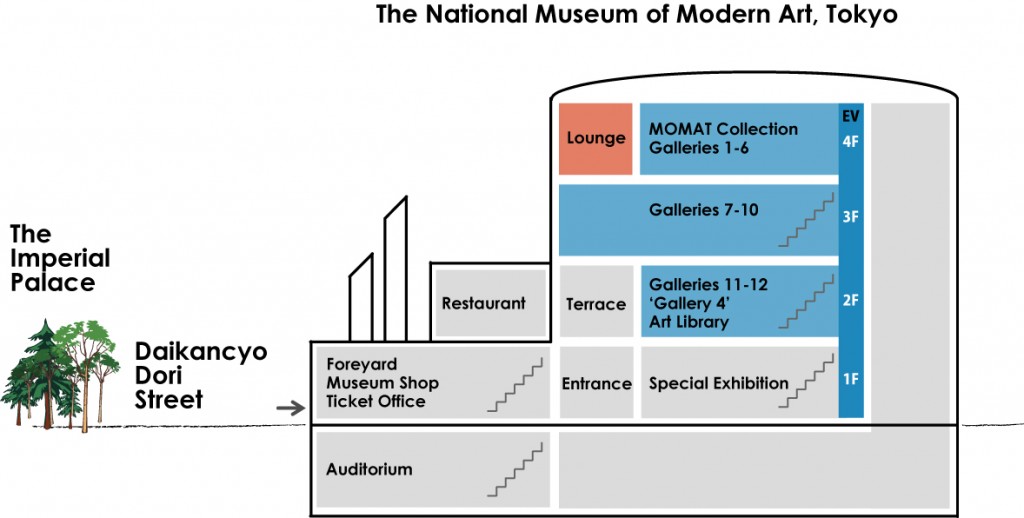
MOMAT Collection comprises twelve(or thirteen)rooms and two spaces for relaxation on three floors. In addition, sculptures are shown near the terrace on the second floor and in the front yard. The light blue areas in the cross section above make up MOMAT Collection. The space for relaxation A Room With a View is on the fourth floor.
The entrance of the collection exhibition MOMAT Collection is on the fourth floor. Please take the elevator or walk up stairs to the fourth floor from the entrance hall on the first floor.
4F (Fourth floor)
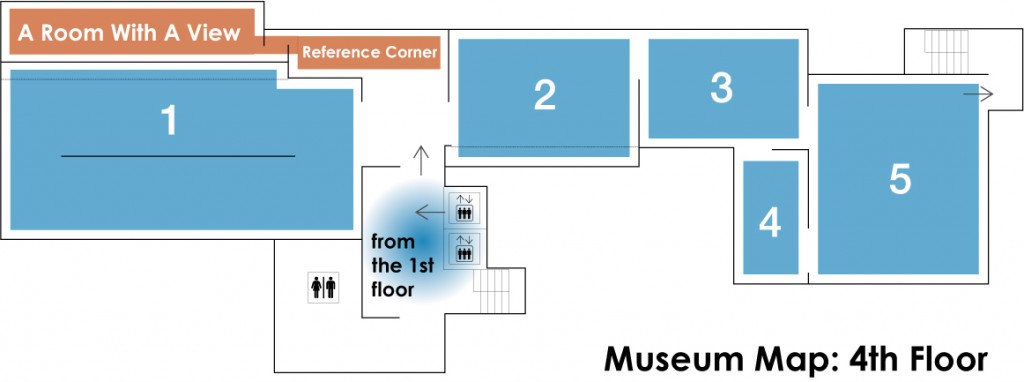
Room 1 Highlights * This section presents a consolidation of splendid works from the collection, with a focus on Master Pieces.
Room 2– 5 1900s-1940s
From the End of the Meiji Period to the Beginning of the Showa Period
A Room With A View
Reference Corner
Room 1 Highlights
The MOMAT Collection, drawn from the museum’s holdings, consists of over 200 works displayed over a 3,000-square meter area. To start off the exhibition, we present the “Highlights” section, consisting of some of the collection’s most essential works, including Important Cultural Properties. For the walls of this newly established space (part of a 2012 effort to renovate the collection galleries), we have selected navy blue to create a more beautiful contrast with the works. And to eliminate the glare of glass cases, we have chosen mat black for the floor, to enhance viewers’ concentration.
This edition of the exhibition includes Nihon-ga (Japanese-style paintings) by Kikkawa Reika, Yuki Somei, Hirafuku Hyakusai, and Kaburaki Kiyokata, all of whom were associated with a Taisho-era research group called Kinreisha. Don’t miss Hirafuku’s Crane and Blue Waves, with its ebullient atmosphere, and Kaburaki’s Portrait of San’y utei Encho, an Important Cultural Property on limited display until January 15. In the Western-painting category, viewers can enjoy comparing works by Yasui Sotaro and Umehara Ryuzaburo, who were known as champions of “Japanese-style oil painting,” and Noda Hideo and Matsumoto Shunsuke, who reconfigured fragmentary images in montage-style works.
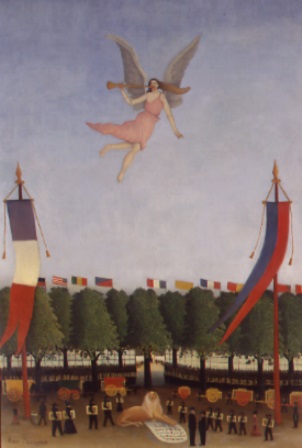
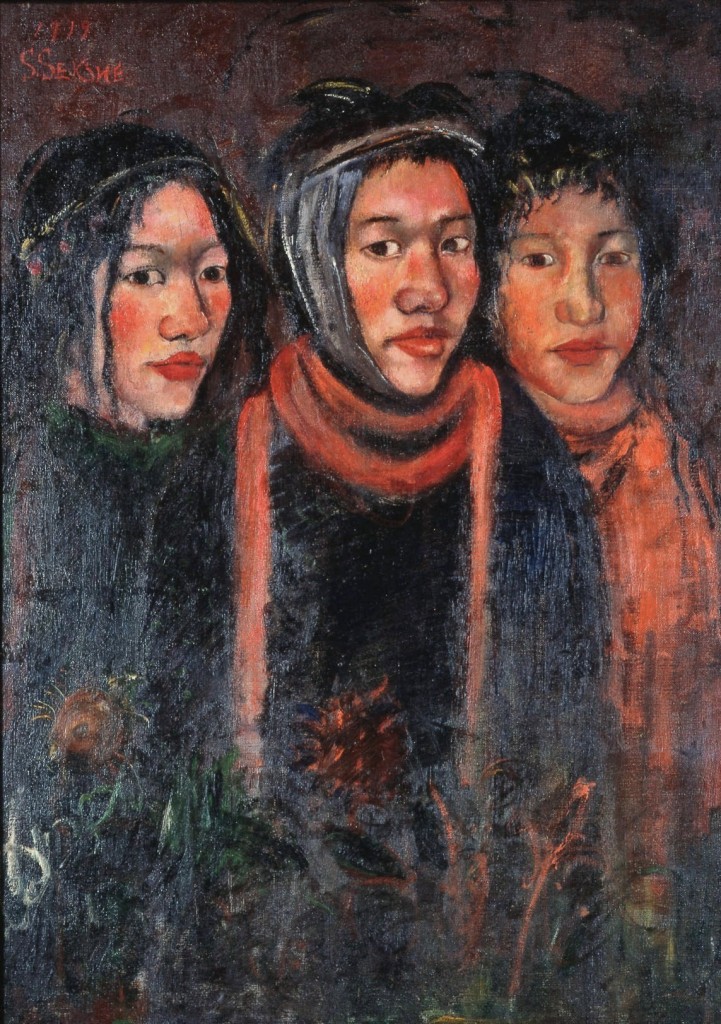
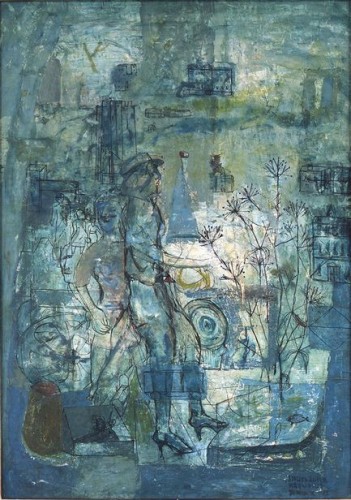
Black Flowers, 1940
Room 2 New or Old?

Determining the beginning of something is always a difficult task. The middle “m” in MOMAT stands for “modern.” But when did modern art really start? Half of these works were displayed in the Bunten, an annual exhibition launched by the Ministry of Education in 1907. Though opinions vary, some have suggested that this event marks the beginning of modern art in Japan.
This was an era in which modern meant “avant-garde.” In other words, the recent past was seen as something old that should be rejected and surmounted. Though the Bunten was initially welcomed, it soon became a stronghold for rigid Academicism and a target of criticism among the younger generation. The rest of these works were made by artists who intentionally veered away from the exhibition.
Do these works, created some 100 years ago, convey the feeling that new things are more magnificent than old ones or vice versa ?
Room 3 Resonating Ryusei
Kishida Ryusei (1891-1929) was one of the most prominent Japanese modern artists. One way to enjoy Kishida’s art is to carefully compare his works.
Take, for instance, these two self-portraits, made a year apart. The color, touch, and signatures are different in each work. The reason the male figure in the 1914 picture looks glummer probably has to do with the shading. Based on the date, we can assume that Kishida completed this painting the day before his daughter Reiko was born. (The 1913 work was made about four months after the artist got married.)
Kishida’s portraits of Mr. Koya, a doctor, convey different impressions of the man through the use of watercolor or oil paint. The most immediate difference between the two pictures is that Koya is holding some Asian flatsedge in the oil painting, but are also some other differences. A closer look reveals subtle differences in his hairstyle, left eyelid, and the angle of his face.
Plants appear in some of Kishida’s other works. For example, a picture of Reiko at five years old shows her clutching some creeping smartweed. She holds the plant differently from Koya, but which way has a more adult appearance? There is also some grass in Kishida’s painting of the pot. As we compare the plant pattern and signature, we realize that there is a quiet resonance between the forms.
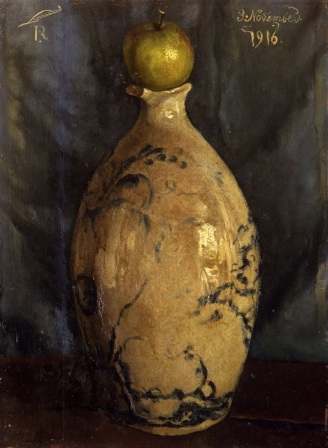
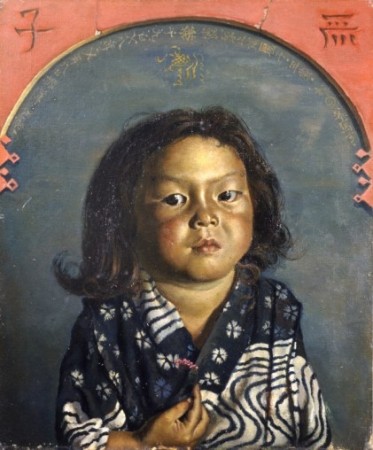
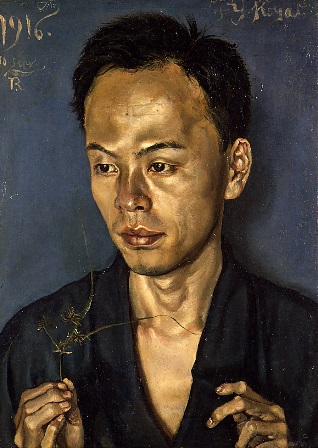
Room 4 Hada Teruo

In Room 4, we present pen drawings by Hada Teruo (1887-1945) from around 1916. They were acquired in 2012, but this is the first time all 11 (as well as a self-portrait) have been shown together.
At the time, Hada’s works were consistently dark and gruesome. He visited pleasure quarters such as Yoshiwara and establishments of unlicensed prostitution in search of subject matter, and produced works such as Blood Pond (1919, collection of the National Museum of Modern Art, Kyoto). Hada was seen as all the more heretical because these were Nihon-ga (paintings made with traditional Japanese art materials). The strangeness of his subject matter comes across forcefully in these pen drawings as well.
In fin-de-siècle Europe a good deal of art with a decadent mood, such as the work of Aubrey Beardsley (1872-98), was being produced, which evidently influenced Hada for a time. At the same time, he was a man with great warmth and love for humanity. Everyone who knew him relates that underlying his grim paintings was a wealth of compassion for their subjectsthe weak and criticism of social injustices.
Room 5 Avant-garde Painting of the 1930s
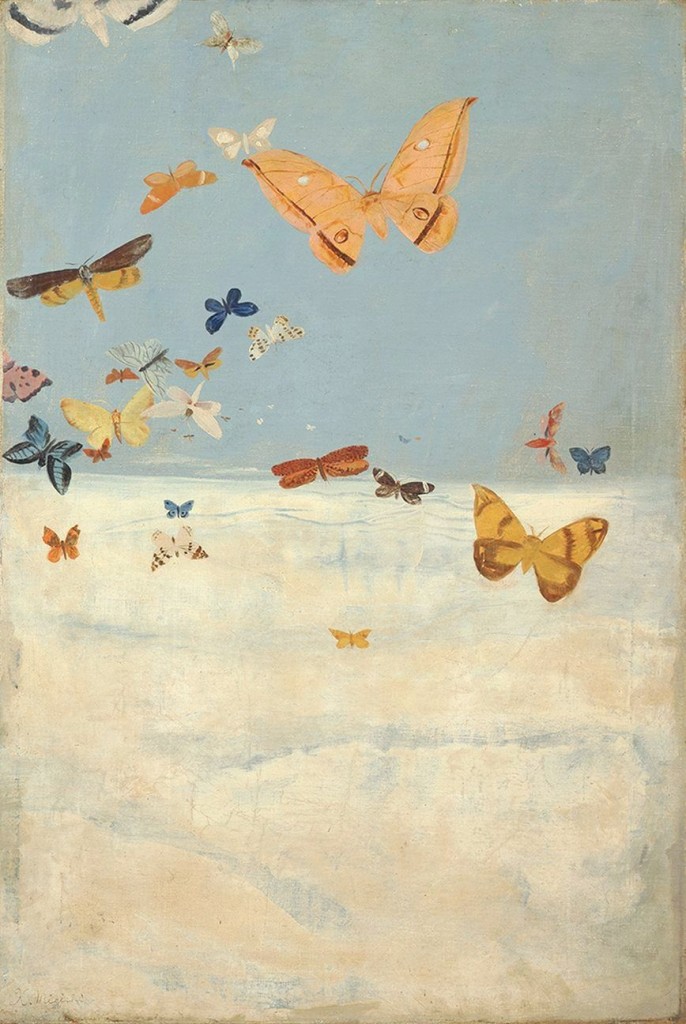
In this exhibition, we examine Japanese avant-garde painting of the 1930s in conjunction with EI-Q 1935-1937: Seeking the “Real” in the Dark, currently on display in Gallery 4 (2nd floor).
At the time that Ei-Q made his debut in the art world in 1936, Surrealism and abstract painting were attracting the attention of many young Japanese artists as part of the so-called “avant-garde.” While abstract painting was rooted in intellectual compositions, Surrealism was concerned with discovering irrational beauty that was not subject to the power of human reason. Though the two movements might seem like polar opposites, the ’30s were an age of mechanical development accompanied by an increasing anxiety toward the war – both pressing themes for artists. Ei-Q, who was interested in both abstract painting and Surrealism, searched for a unique way of capturing the reality of the times. In letters to a friend , he expressed admiration for artists like Koga Harue and Migishi Kotaro. At the same time, he was friendly with abstract painters like Hasegawa Saburo, Murai Masanari, and Onosato Toshinobu, with whom he formed the Jiyu Bijutsuka Kyokai (Free Artists’ Association).
3F (Third floor)
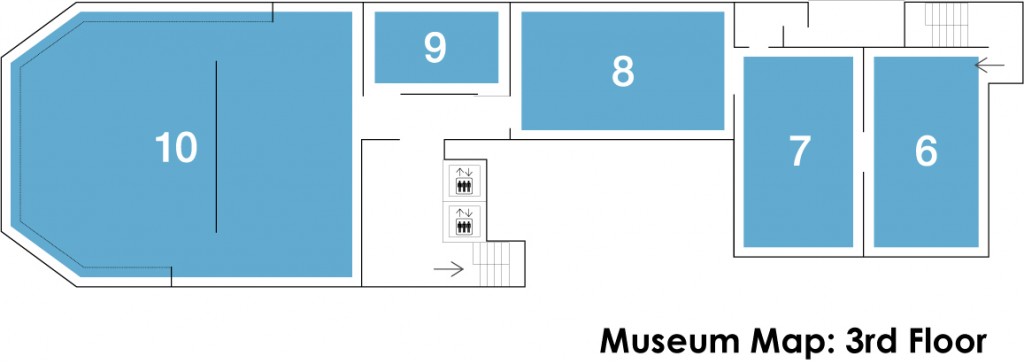
Room 6-8 1940s-1960s
From the End of the Meiji Period to the Beginning of the Showa Period
Room 9 Photography and Video
Room 10 Nihon-ga (Japanese-style Painting)
Room to Consider the Building
Room 6 The War-record Paintings of Nakamura Kenichi
The painter Nakamura Kenichi (1895-1967) was born in Fukuoka Prefecture. After graduating from the Tokyo School of Fine Arts (now, Tokyo University of the Arts), he studied in Paris from 1923 to 1928. Using a solid, realistic depiction, Nakamura proved particularly adept at painting groups of people with urban manners. Partially due to the fact that his father-in-law was a rear admiral, Nakamura became actively involved in making war-record paintings during World War II.
In Naval Battle off Malaya and Battle of the Coral Sea, machines (battleships and fighter planes) are the protagonists in a spectacle that unfolds across an expansive landscape. On the other hand, in Kota Baru and Army-Navy Joint Operations on Tasivarongo Point, Guadalcanal, the artist captures a tense group of soldiers. All of these large pictures were based on on-site sketches, interviews with the military, and live drawings of soldiers made in Nakamura’s studio. As suggested by the fact that Kota Baru depicts a Japanese attack from the perspective of the enemy, Nakamura did not simply paint scenes that he saw, but skillfully crafted them to heighten the dramatic effect.
Room 7 Signs and Circumstances of Survival
The Bathroom series is an early work by Kawara On that he made when he was around 20. As the protagonists decrease, increase, and change places in the tile-covered room, they witness a blood bath, which lacks both context and beginning or end. Many viewers are likely to be reminded of Kafka’s The Metamorphosis. In that novella, the main character, Gregor Samsa, awakes one morning to find that his body has been transformed into a “monstrous vermin.” Samsa simply accepts this as an ordinary occurrence – without either bewailing his fate or viewing the change as some kind of curse. Similarly, the men and women in Kawara’s works maintain their composure despite finding themselves in the midst of a tragedy. To shed light on the gratuitous nature (factual aspects) of human life and death, both Kawara and Kafka felt the need to distance themselves from standard realism, and adopt pseudo-sci-fi settings and manga-like approaches. The same focus on the factual nature of survival can also be seen in Kawara’s “Date Paintings,” a long-running series that he began in 1966. These works eternally convey the fact that the artist lived on a given date in a given year.
Room 8 From a Single Straight Line
In the past, the word “painting” signified something in which a figure was painted on a ground – as if an object perfectly occupied the space. After World War II, this convention was broken with a horizontal or vertical line that extended from one edge of the canvas to the other.
These striped and grid-like structures, made with inorganic and endlessly repeating lines and rectangular units, are probably have no relation to the poetic quality of the “infinite cosmos.” This group of works proves that even when subjected to the limitations of such unimpassioned structures, it is abundantly possible to make a painting. They include a two-color construction that faintly rises up from the canvas once our eyes become adjusted (Ad Reinhardt); minute irregularities and fluctuations in countless forms depicted freehand without the use of masking tape (Onosato Toshinobu); slight ruptures and disparities in regulated patterns (Tatsuno Toeko and Sawai Yoko); and twists and varying speeds in horizontal brushstrokes that resemble a stream (Iwamoto Takuro). As we look at these works, our vision seems to vibrantly swing back and forth.
Room 9 Modern German Photography: New Vision and New Objectivity
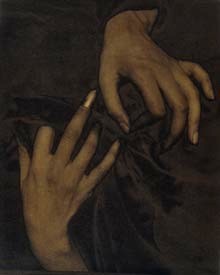
Alfred Stieglitz was an important American photographer who played a crucial role in establishing photography as an art form.
Stieglitz went to Germany to study photographic chemistry and Pictorialism, a type of photographic expression that was popular at the time. After returning to the U.S. in 1902, Stieglitz, based in New York, formed the Photo-Secession with a group of highly distinguished photographers living all over the country. He also went to great lengths to develop photography as an art by publishing a magazine and running a gallery.
In his early works, Stieglitz focused on picturesque scenes on the street of the city, and by instantaneously capturing a perfect composition, he strove to create expressions that were unique to the photographic medium. His “straight” method of capturing a piece of the world without altering the negatives or prints gradually developed into what Stieglitz referred to as the “equivalent” aesthetic. In this approach, the subject, the photographer’s inner feelings, and the viewer’s sensibilities were all viewed as equals.
In 1953, not long after MOMAT opened, Stieglitz’s widow, the painter Georgia O’Keeffe, donated a number of the photographer’s works to the museum. On the 70th anniversary of Stieglitz’s death, we present a group of works (primarily those that we received from O’Keeffe) that stretches from the beginning to the end of his career.
Room 10 Samurai in Painting
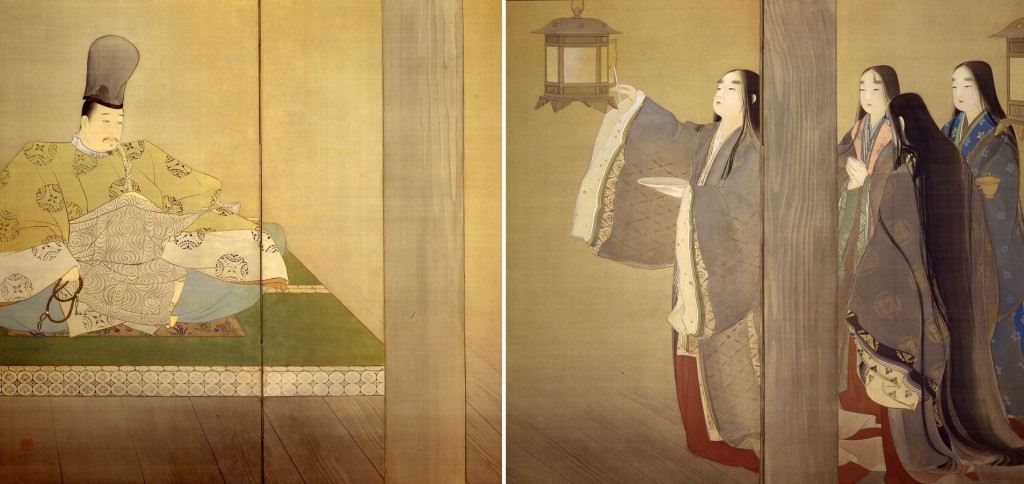
In Yoshitsune-den (The Legend of Yoshitsune) (Tokyo Bunkaido Shoten), published in 1914, Kuroita Katsumi (1874-1946) cites three men as embodiments of Bushido, the Way of the Samurai: Kusunoki Masashige, who faithfully served Emperor Go-Daigo of the Southern Court; Hojo Tokimune, who successfully defied the invading Mongols during the Genko War; and Minamoto no Yoshitsune, who fought fiercely to defend his clan. Kuroita states that these three samurai represent the three Bushido tenets of “loyalty”, “defense of the country”, and “piety” respectively, and all of them have been portrayed extensively in modern Nihon-ga (Japanese-style) painting.
From the start, history painting was a genre that embodied the values and ethics of the day, and was expected to play a role in public education. How did modern Japanese painters select and shape their subject matter in line with these expectations? In this section we present works from the collection with a primary focus on war paintings.
By contrast, the section just ahead will have a peaceful theme: to celebrate the new Year of the Rooster, we present Nihon-ga paintings featuring a wide variety of birds. Look for a curious flightless bird from down under in Hieda Kazuho’s Kiwi.
2F (Second floor)
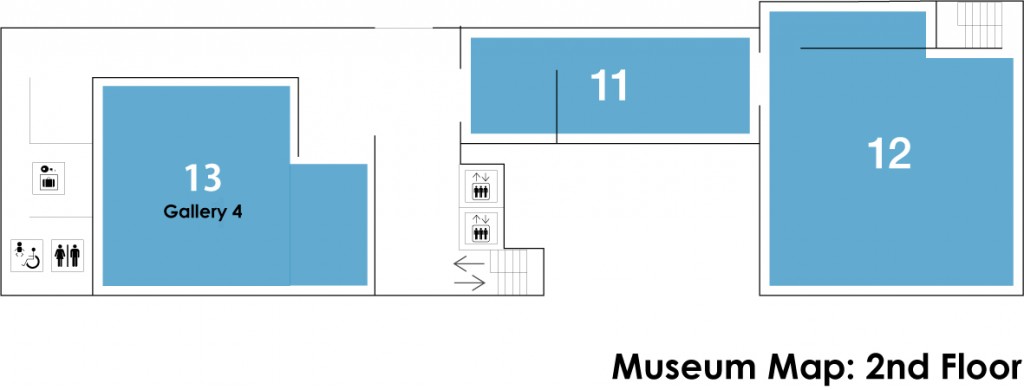
Room 11-12 1970s-2010s
From the End of the Showa Period to the Present
Gallery 4
* A space of about 250 square meters. This gallery offers cutting-edge thematic exhibitions from the Museum Collection, and special exhibitions featuring photographs or design.
EI-Q 1935-1937: Seeking the “Real” in the Dark
Room 11 Special Aluminum
Aluminum exists as part of a compound in nature. It was discovered in 1807 using an electrochemical. In 1887, a method of producing aluminum from the raw material of bauxite was developed.
Aluminum smelting began in Japan in 1934. Light and strong yet flexible and easy to process, the metal was primarily used in the munitions industry. After World War II, aluminum became widespread in everyday items, and by the time it was chosen as the material for one-yen coins in 1955, aluminum had become completely commonplace.
With the emergence of an artistic movement to question materiality in the 1960s, aluminum came to be a popular new material – along with stainless steel and synthetic resin. But in light of the fact that stainless steel is an alloy and synthetic resin is a high-polymer-, aluminum (with its ability to be artificially separated from compounds) is markedly different in terms of its material qualities. With this in mind, we present three works that employ aluminum as their chief component.
Room 12 Representative or Transcendent?
In this section, we introduce a group of paintings, dating from the 1970s and later, that are representative of each era.
The ’70s are represented by Lee Ufan and Saito Yoshishige. Both in terms of theory and practice, Lee was a leading figure in Mono-ha, an important movement in Japanese art from the late ’60s to the early ’70s. For his part, Saito, a professor at Tama Art University, exerted a strong influence on young Mono-ha artists like Suga Kishio and Sekine Nobuo.
The ’80s are represented by Ohtake Shinro. Along with Hibino Katsuhiko, Ohtake, who boldly adopted the installation format and design methods and sensibilities, is an iconic figure of the period.
The ’90s are represented by Nara Yoshitomo. Nara’s works not only incorporate visual elements associated with religious art and picture books, but also the musical spirit of rock and punk. In the sense that his work creates a strong affinity (or total rejection) with viewers, Nara has further developed the potential of painting.
Of course, there are also works that transcend the spirit of the times in which they were created. One example of this is Murakami Tomoharu, who felt obliged to make paintings as an accumulation of everyday acts that are equal to prayer.
About the Exhibition
- Location
-
Collection Gallery, from the fourth to second floors
- Date
-
November 22, 2016 – February 12, 2017
- Time
-
10:00-17:00 (10:00 – 20:00 on Fridays and Saturdays)
*Last admission is 30 minutes before closing. - Closed
-
※Mondays (except January 2 and 9, 2017) and December 28, 2016 – January 1 and January 10, 2017
- Admission
-
Adults ¥430 (220)
College and university students ¥130 (70)*Including the admission fee for MOMAT Collection and EI-Q 1935-1937: Seeking the “Real” in the Dark.
*The price in brackets is for the group of 20 persons or more.
*All prices include tax.
*Free for high school students, under 18, seniors(65 and over), Campus Members, MOMAT passport holder.
*Show your Membership Card of the MOMAT Supporters or the MOMAT Members to get free admission (a MOMAT Members Card admits two persons free).
*Persons with disability and one person accompanying them are admitted free of charge. *Members of the MOMAT Corporate Partners are admitted free with their staff ID. - Free Admission Days
-
Collection Gallery and Gallery 4
Free on December 4 2016, January 2, February 5, 2017 - Organized by
-
The National Museum of Modern Art, Tokyo


